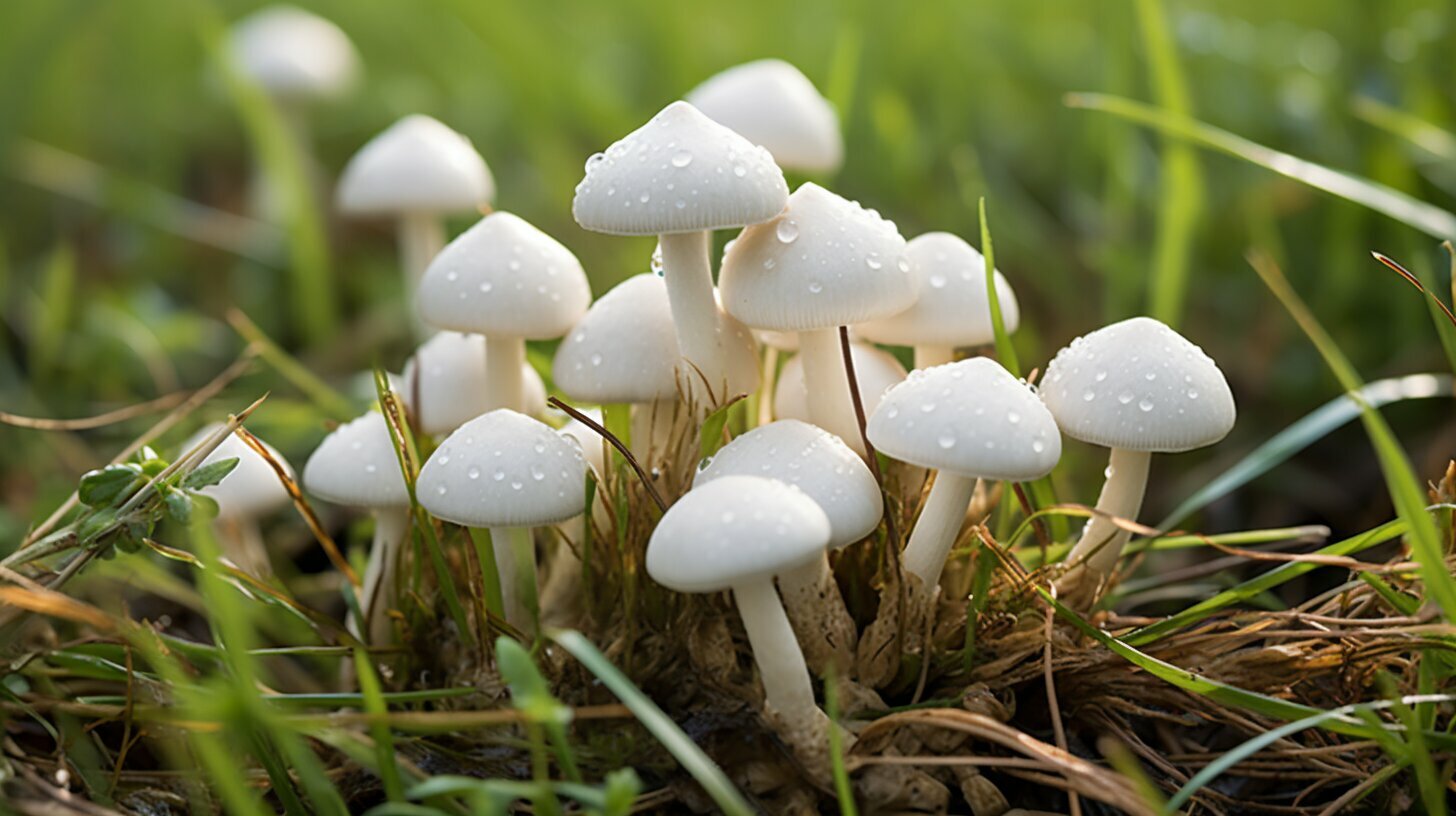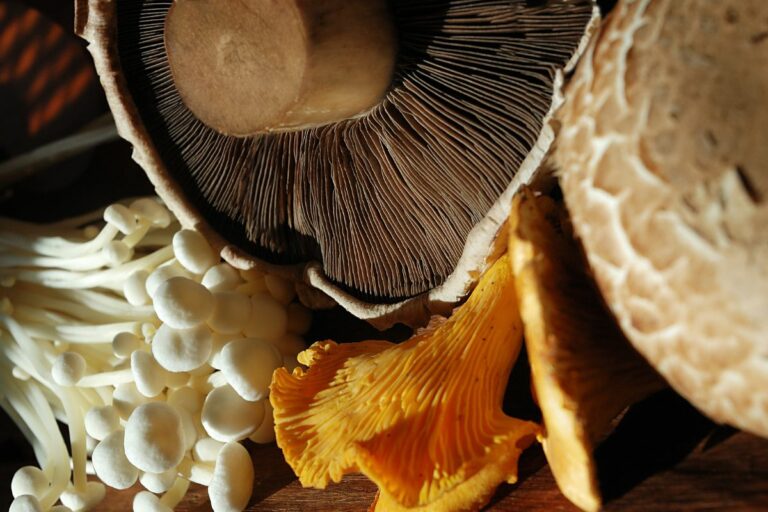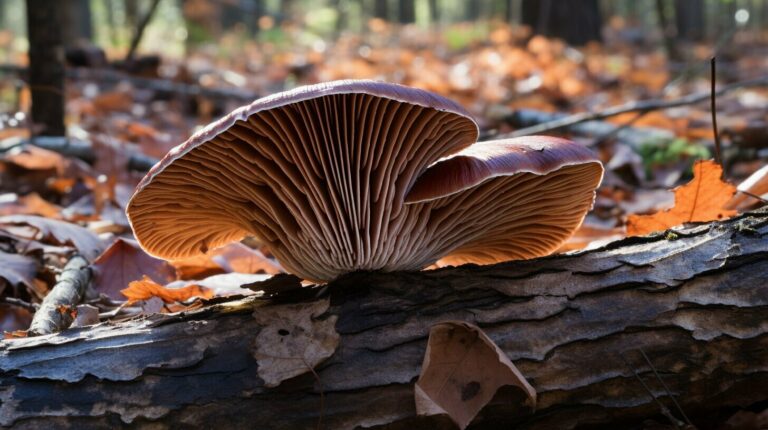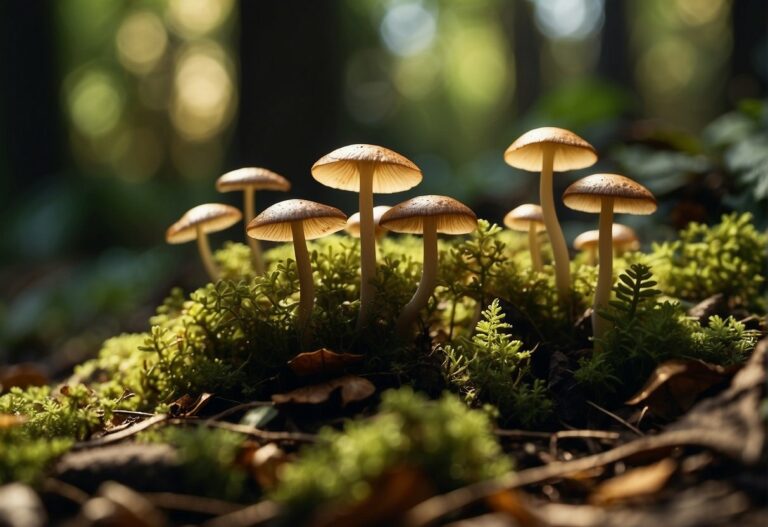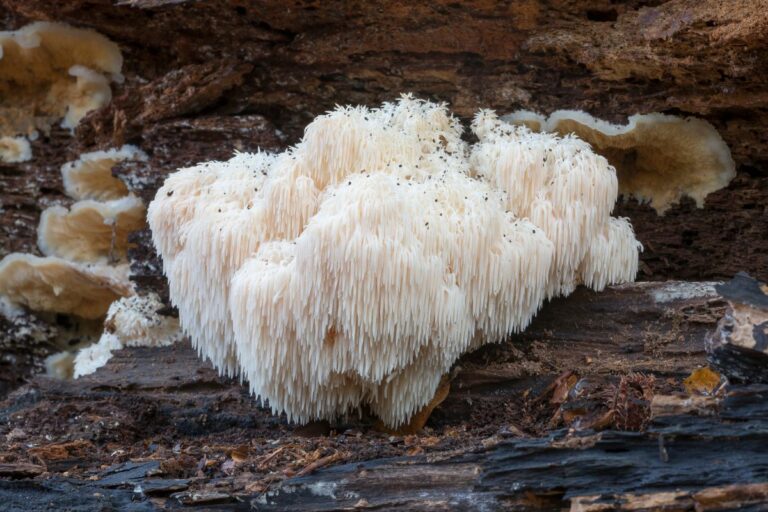Yard mushrooms are a common feature in many backyard lawns, but it’s crucial to be aware of their types, how to identify them, and which ones are potentially harmful or edible. Mushrooms that grow in backyard lawns are the fruiting bodies of underground fungi that play a vital role in breaking down organic matter in the soil, contributing to the ecosystem. However, it’s important to exercise caution when dealing with yard mushrooms, as some can be poisonous if consumed.
These mushrooms thrive in environments rich in organic material, damp and humid conditions, and shady or sheltered areas. Some common types of backyard mushrooms include the ringless honey mushroom, field or meadow mushroom, common stinkhorn, mower’s mushrooms, shaggy ink cap, fly agaric, fairy ring mushroom, and giant puffball.
Proper identification is essential when it comes to yard mushrooms. While some varieties are edible and can be foraged and enjoyed, others can be toxic or even deadly if ingested. It’s important to teach children and keep pets away from mushrooms to avoid any potential harm.
Additionally, the presence of mushrooms in your lawn can indicate underlying issues such as poor drainage or excessive thatch buildup. Monitoring their growth and understanding the causes can help you address any problems and maintain a healthy lawn.
In this informative guide, we will delve into the different types of yard mushrooms, how to identify them, and their potential risks and benefits. Whether you are curious about their ecological role, interested in foraging for edible varieties, or simply want to learn more about the wild mushrooms in your yard, this guide will provide you with valuable insights.
Understanding Yard Mushroom Species
Table of Contents
Yard mushrooms come in various species and varieties, offering a fascinating sight for nature enthusiasts and curious homeowners. These unique organisms, also known as fruiting bodies, are the visible part of the fungus that grows beneath the soil. They play a crucial role in the ecosystem by breaking down organic matter, turning dead plants and debris into rich nutrients for the soil.
Backyard lawns can host a diverse range of mushroom species, each with its own distinctive characteristics. Some common varieties include the ringless honey mushroom, field or meadow mushroom, common stinkhorn, mower’s mushrooms, shaggy ink cap, fly agaric, fairy ring mushroom, and giant puffball. Each species differs in shape, color, and size, adding to the intrigue of discovering these unique fungi in your yard.
When exploring yard mushrooms, it’s essential to exercise caution and avoid consuming any wild mushrooms unless you are an expert in identification. Some mushrooms may be toxic or even deadly if ingested. To aid in identification, various field guides and online resources can provide detailed information, including visual cues, spore prints, and habitat preferences for different mushroom species. It’s important to note that even visually similar mushrooms can have significant differences in toxicity, so accurate identification is crucial.
Table: Common Yard Mushroom Species
| Species | Characteristics |
|---|---|
| Ringless Honey Mushroom | Cap: Yellow-brown or honey-colored, slimy when wet. Stem: Whitish with a ring towards the top. |
| Field or Meadow Mushroom | Cap: White or tan, smooth and convex. Stem: White, often with a small ring. |
| Common Stinkhorn | Cap: Cone-shaped, slimy, and covered in a foul-smelling slime. Stem: White with brownish or blackish tip. |
| Mower’s Mushrooms | Cap: Brownish or tan, scaly and convex. Stem: White, often with a ring. |
| Shaggy Ink Cap | Cap: Brownish or grayish, covered in shaggy scales. Stem: White with a distinctive shaggy appearance. |
| Fly Agaric | Cap: Bright red with white spots. Stem: White, often with a ring. |
| Fairy Ring Mushroom | Cap: Varies in color from white to brown or tan. Stem: White or off-white. |
| Giant Puffball | Cap: Round or pear-shaped, white and smooth. Stem: Absent or very short. |
While yard mushrooms can add natural beauty to your lawn and contribute to the ecosystem, their presence can also indicate underlying issues such as poor drainage or excessive thatch buildup. If you notice an abundance of mushrooms in your yard, it’s advisable to assess and address any underlying issues to maintain a healthy lawn. Additionally, remember to keep children and pets away from mushrooms, as some can be toxic or deadly if ingested.
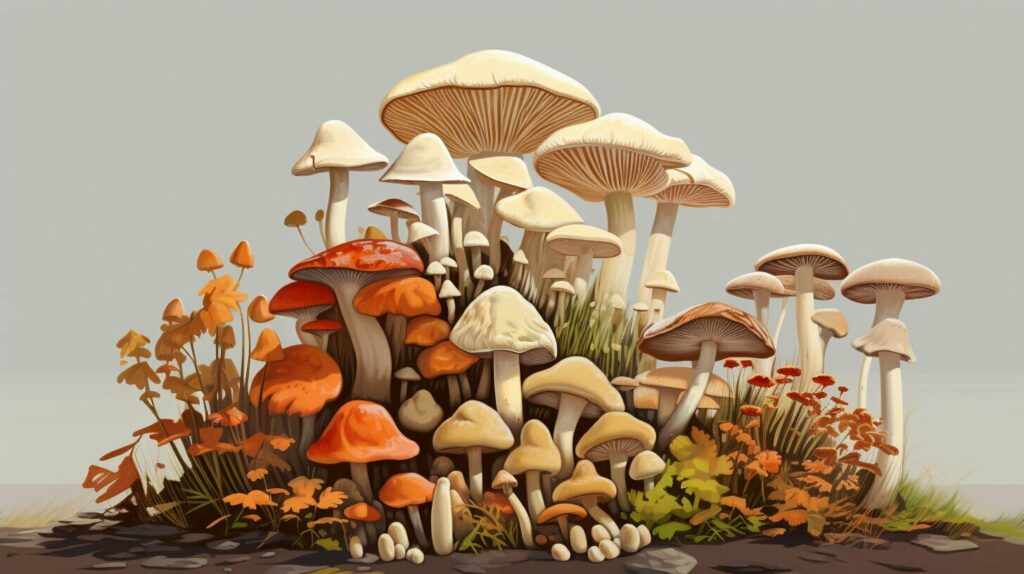
Yard mushrooms are a fascinating part of nature’s diversity, offering a glimpse into the hidden world beneath the soil. By understanding the different species and exercising caution, you can appreciate the beauty and ecological significance of these mysterious fungi that thrive in your own backyard.
Identifying Common Yard Mushrooms
Among the many types of yard mushrooms, several species are commonly encountered in backyard lawns. These mushrooms can vary in appearance, size, and color, making identification a crucial step in distinguishing between edible varieties and potentially poisonous ones. The following are some of the most frequently seen yard mushrooms:
| Mushroom Species | Description |
|---|---|
| Ringless Honey Mushroom | A honey-colored mushroom with a ringless stalk and a smooth cap. It often grows in clusters and is known for its edible qualities. |
| Field or Meadow Mushroom | A medium-sized mushroom with a white or beige cap and pink gills. It typically grows in grassy areas and is considered edible. |
| Common Stinkhorn | A foul-smelling mushroom with a distinctive bell-shaped cap and a long, slimy stalk. It is not suitable for consumption. |
| Mower’s Mushrooms | These small, white mushrooms often appear in lawns after mowing. They are generally harmless but not recommended for consumption. |
| Shaggy Ink Cap | A mushroom with a shaggy, off-white cap that disintegrates into an inky substance as it matures. It is edible when consumed before the ink stage. |
| Fly Agaric | Recognizable by its bright red cap with white spots, this mushroom is highly toxic and should never be consumed. |
| Fairy Ring Mushroom | A mushroom that forms in circular patterns, often with a white or light brown cap and a pale stem. It is generally harmless but not recommended for consumption. |
| Giant Puffball | A large, spherical mushroom with a white, smooth surface. It is edible when young and has a firm texture. |
While these are some common yard mushrooms, it’s important to note that visual identification alone may not always be accurate. If you are unsure about a mushroom’s edibility, it is best to consult an expert or leave it untouched. Remember, even edible mushrooms can cause negative reactions in some individuals, so it’s essential to exercise caution when foraging or consuming wild mushrooms.
“The mushroom is the elf of plants, the food of fairies, and the symbol of perpetual youth,” – Heinrich Heine
Understanding and recognizing the different species of yard mushrooms can help you appreciate the diverse fungi that inhabit your lawn, but it is crucial to prioritize safety. Do not consume any mushroom unless you are absolutely certain of its identity and edibility. Always remember to teach children about the potential dangers of mushrooms and keep pets away from them to prevent accidental ingestion.
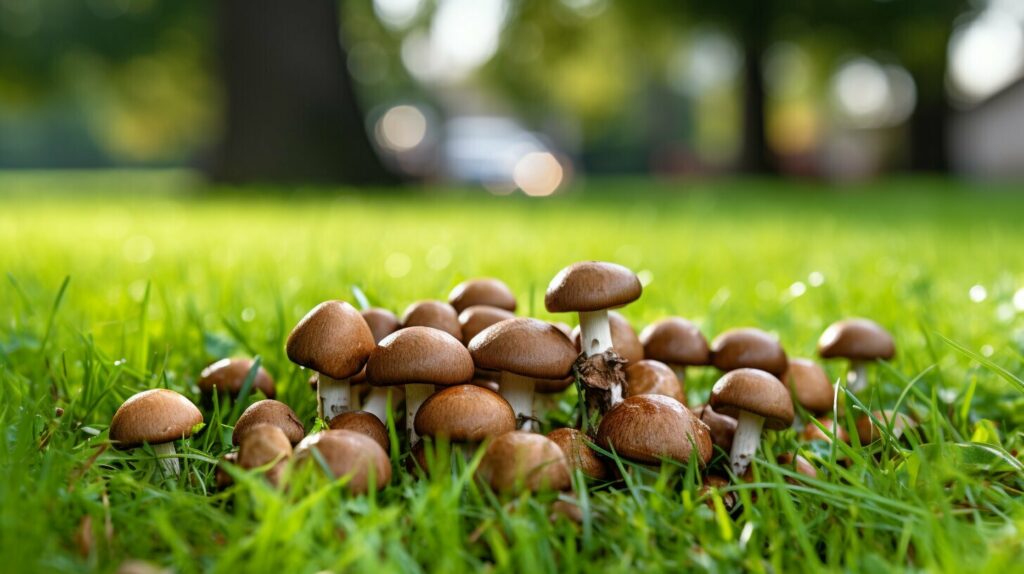
- Several types of yard mushrooms are commonly found in backyard lawns.
- Identification is crucial to determine the edibility and potential toxicity of mushrooms.
- Common yard mushrooms include the ringless honey mushroom, field or meadow mushroom, common stinkhorn, mower’s mushrooms, shaggy ink cap, fly agaric, fairy ring mushroom, and giant puffball.
- Visual identification alone may not always be accurate, so caution is advised.
- If uncertain about a mushroom’s edibility, consult an expert or leave it untouched.
- Teach children about the potential dangers of mushrooms and keep pets away from them.
Recognizing Poisonous Yard Mushrooms
While many yard mushrooms are harmless, it’s important to be able to recognize and steer clear of the potentially dangerous ones. Some varieties can cause severe illness or even be lethal if consumed. Here are some key features to look out for when identifying poisonous yard mushrooms:
- Unusual colors: Poisonous mushrooms often have vibrant colors, such as bright red, yellow, or purple. These eye-catching hues serve as a warning sign to potential predators.
- Gills or spines: Take note of the mushroom’s underside. If it has gills, which are thin, blade-like structures, or spines, it is crucial to be cautious as these are commonly found in toxic species.
- Distinctive odor: Some poisonous mushrooms have a strong and unpleasant odor. If you come across a mushroom with a foul smell, it’s best to avoid it.
- Unusual shapes: Certain poisonous mushrooms have distinctive shapes, such as a bell-shaped cap or a prominent bulbous base. These unique characteristics can help in identification.
“When in doubt, it is always better to err on the side of caution and avoid consuming any wild mushrooms without proper identification.”
Remember, the best way to ensure your safety is to refrain from consuming any mushrooms found in your yard unless you are confident in their identification as an edible variety. If you suspect that your child or pet has ingested a poisonous mushroom, seek immediate medical attention. To learn more about identifying different types of mushrooms and their potential risks, consult with a local mycologist or mushroom foraging expert. Stay informed, stay safe!
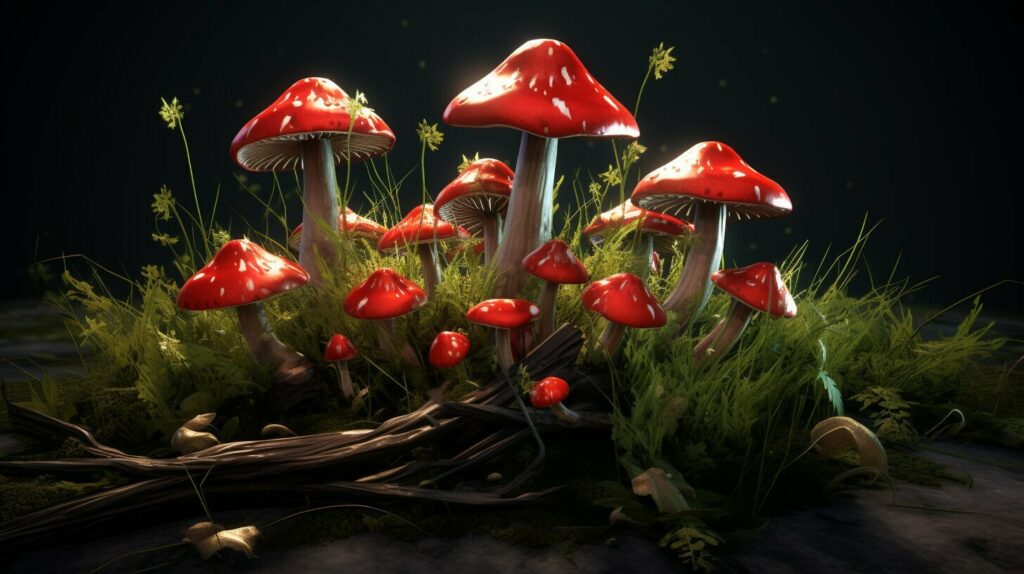
| Mushroom Name | Appearance | Known Toxicity |
|---|---|---|
| Death Cap | White with a greenish-yellow cap | Highly toxic, potentially fatal |
| Destroying Angel | Pure white with a large, bell-shaped cap | Deadly poisonous |
| False Morel | Brownish-red, brain-like cap | Can cause severe illness |
| Little Brown Mushroom | Small, brownish cap with beige gills | Various species are toxic |
Remember:
Always be cautious when dealing with yard mushrooms. Educating yourself on the different species, their identification features, and potential risks is crucial for your safety. If you’re unsure about a mushroom’s edibility or suspect it may be poisonous, consult an expert or leave it untouched. By following these precautions, you can enjoy the beauty of yard mushrooms while avoiding any potential harm.
Delving into Edible Yard Mushrooms
For those interested in venturing into the culinary possibilities of yard mushrooms, there are a few species that are safe to eat and can add a unique flavor to your dishes. Before embarking on your mushroom foraging journey, it’s crucial to remember the importance of proper identification and caution.
One of the most popular edible yard mushrooms is the shaggy mane (Coprinus comatus). This distinctive mushroom features a tall, white stem and a cap that turns black and liquefies as it matures. With its delicate flavor and tender texture, the shaggy mane is a prized addition to soups, stews, and sautés.
“The shaggy mane is a versatile mushroom that pairs well with a variety of ingredients,” says renowned chef Jane Monroe. “Its unique flavor profile offers a hint of earthiness and a touch of nuttiness, making it a delightful addition to any mushroom dish.”
Another delicious edible yard mushroom is the oyster mushroom (Pleurotus ostreatus). This mushroom has a distinctive oyster-like shape and comes in various shades of white, yellow, and gray. With its delicate, nutty flavor, the oyster mushroom is a popular choice for stir-fries, pasta dishes, and risottos.
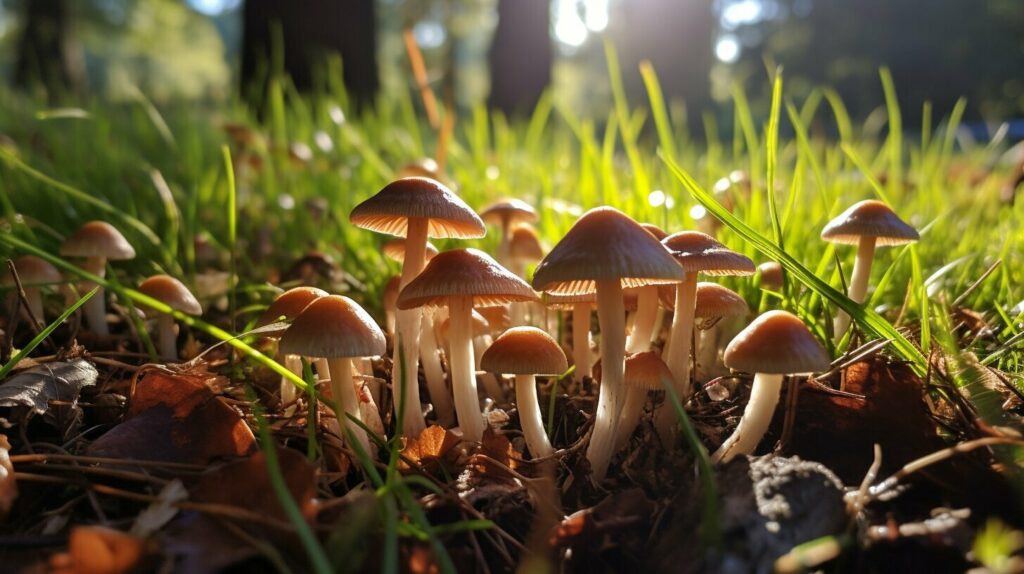
| Mushroom Species | Flavor Profile | Culinary Uses |
|---|---|---|
| Shaggy Mane | Delicate, nutty | Soups, stews, sautés |
| Oyster Mushroom | Nutty | Stir-fries, pasta dishes, risottos |
When harvesting edible yard mushrooms, it’s essential to only pick specimens that are in prime condition and free from rot or decay. Remember to leave some mushrooms behind to ensure the preservation and propagation of the species.
So, the next time you come across mushrooms in your yard, don’t be afraid to explore their culinary potential. With proper identification and caution, you can enjoy the unique flavors and textures that edible yard mushrooms have to offer.
The Role of Yard Mushrooms in the Ecosystem
Yard mushrooms are not just visually appealing; they also play a crucial role in maintaining a healthy ecosystem within your lawn. These mysterious fungi are the fruiting bodies of underground organisms known as mycelium. Mycelium is responsible for breaking down organic matter, such as dead plants and decaying wood, into nutrients that can be absorbed by other plants. In this way, yard mushrooms contribute to the nutrient cycle and help create fertile soil for your lawn to thrive.
One of the key functions of yard mushrooms is their ability to decompose organic material. They release enzymes that break down complex organic compounds, such as lignin and cellulose, into simpler forms that can be easily absorbed by plants. As they decompose organic matter, mushrooms also release carbon dioxide and other byproducts back into the atmosphere. This process helps to regulate carbon levels in the soil and maintain a healthy balance of nutrients.
Yard mushrooms also form symbiotic relationships with certain tree roots, known as mycorrhizal associations. This mutually beneficial partnership allows mushrooms to exchange nutrients with trees. The mushrooms provide the tree with essential minerals and help improve its overall health and resilience. In return, the tree supplies the mushrooms with carbohydrates produced through photosynthesis. This symbiotic relationship not only benefits the tree and mushrooms but also enhances the overall biodiversity of the ecosystem.
| Common Name | Scientific Name | Appearance |
|---|---|---|
| Ringless Honey Mushroom | Armillaria tabescens | Small to medium-sized, honey-colored caps; white spore print |
| Field or Meadow Mushroom | Agaricus campestris | White to light brown caps; pink to brown gills; white spore print |
| Common Stinkhorn | Phallus impudicus | Tall, white to pink structures with a foul odor; spore mass covered in a slimy coating |
| Mower’s Mushrooms | Panaeolus foenisecii | Small, brown to straw-colored caps; dark gills; black spore print |
While yard mushrooms are an integral part of the ecosystem, it’s essential to exercise caution when dealing with them. Some mushrooms can be toxic or deadly if ingested, so it’s important to properly identify them before consuming or allowing children and pets near them. If you’re unsure about the species of a mushroom, it’s best to leave it untouched or consult an expert for identification. By appreciating and respecting the role of yard mushrooms in the ecosystem, you can maintain a healthy and vibrant lawn.

Quote: “Yard mushrooms are like nature’s little recyclers, breaking down organic matter and returning nutrients to the soil.” – Dr. Jane Myers, mycologist.
- Yard mushrooms decompose organic matter, contributing to the nutrient cycle and fertile soil.
- Mushrooms form symbiotic relationships with tree roots, enhancing tree health and biodiversity.
- Exercise caution when dealing with yard mushrooms, as some can be toxic if ingested.
Understanding the Causes of Yard Mushroom Growth
The presence of wild mushrooms in yards can indicate specific underlying conditions that promote their growth, such as dampness, shade, and organic debris. Mushrooms thrive in environments that provide them with moisture and decaying organic material to feed on. Yards with poor drainage or areas that receive excessive watering are more likely to have mushrooms sprouting up. Additionally, shaded or sheltered areas create the perfect conditions for mushrooms to flourish, as they prefer cooler and darker environments.
Organic debris, such as fallen leaves, grass clippings, and dead wood, can also contribute to mushroom growth in yards. These materials provide a nutrient-rich substrate for fungi to break down and feed upon. As the fungi decompose the organic matter, they release spores into the air, which can then settle and germinate in suitable conditions. This process allows mushrooms to spread and populate yards with their unique shapes, colors, and textures.
To better understand the causes of yard mushroom growth, it can be helpful to visualize the conditions through a table:
| Conditions | Effect on Mushroom Growth |
|---|---|
| Dampness | Creates a favorable environment for mushroom spore germination and growth. |
| Shade | Provides a cooler and darker habitat that mushrooms prefer. |
| Organic Debris | Serves as a nutrient-rich substrate for fungi to feed on and thrive. |
| Poor Drainage | Traps moisture in the soil, promoting mushroom growth. |
Understanding the causes of yard mushroom growth can help homeowners identify and address the underlying conditions that contribute to their presence. By improving drainage, reducing shade, and minimizing organic debris accumulation, it is possible to create an environment less conducive to mushroom growth. However, it’s important to note that completely eradicating mushrooms from a yard may be challenging, as they play a vital role in the ecosystem and often return due to their ability to spread through spores.
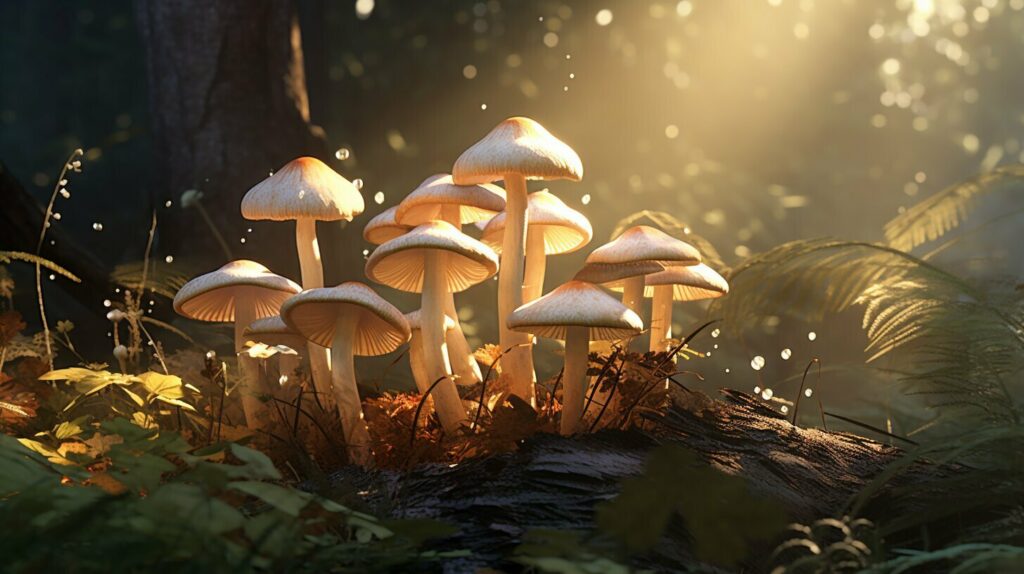
While some homeowners may appreciate the presence of yard mushrooms, others may want to take measures to prevent or control their growth due to concerns over safety or aesthetics. There are several steps you can take to manage yard mushrooms and reduce their occurrence.
- Promote good lawn health: A healthy lawn is less likely to have an abundance of mushrooms. Regularly mow your lawn to the recommended height and practice proper watering and fertilization techniques. This will help create unfavorable conditions for mushroom growth.
- Improve drainage: Mushrooms thrive in moist environments, so improving drainage in your yard can help reduce their growth. Ensure that your yard has proper grading and consider installing drainage systems or redirecting water away from problem areas.
- Remove organic debris: Mushrooms feed on organic matter, so removing any dead leaves, fallen branches, or thatch buildup will reduce their food source.
- Be cautious with fertilizers: While fertilizers are beneficial for promoting lawn health, overuse can contribute to mushroom growth. Follow the recommended application rates and avoid excessive use of nitrogen-rich fertilizers.
- Avoid overwatering: Excessive moisture can create the perfect environment for mushrooms to thrive. Water your lawn deeply but infrequently, allowing the soil to dry out between waterings.
Remember, it’s important to exercise caution when dealing with yard mushrooms. Wear gloves when removing them to avoid direct contact, as some mushrooms can cause skin irritation. If you’re unsure about the identification of a mushroom or have concerns about its toxicity, it’s best to err on the side of caution and avoid consumption.
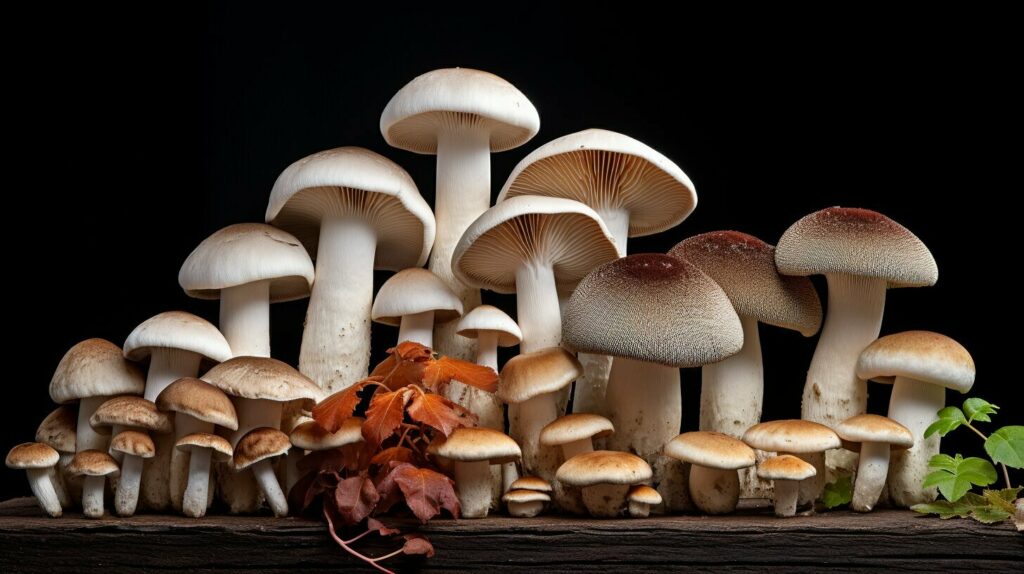
Potential Risks Associated with Yard Mushrooms
It’s essential to be aware of the potential risks associated with yard mushrooms, as some species can be highly toxic if ingested. While many mushrooms found in yards are harmless and even edible, there are certain varieties that can cause severe illness or even be deadly. To ensure your safety and that of your family, it’s crucial to exercise caution when dealing with yard mushrooms.
One of the most significant risks is misidentification. Without proper knowledge and expertise, it can be challenging to distinguish between poisonous and edible mushrooms. Some toxic species may closely resemble edible varieties, making it even more crucial to rely on accurate identification methods. Consuming poisonous mushrooms can lead to various symptoms, ranging from mild gastrointestinal distress to life-threatening liver or kidney damage.
Additionally, the toxicity level of yard mushrooms can vary greatly depending on the species and individual factors such as age, health, and tolerance. It’s crucial to understand that even a mushroom that has been consumed without ill effects in the past can suddenly become toxic. Therefore, it’s essential to avoid casual foraging without comprehensive knowledge and training.
To minimize the risks associated with yard mushrooms, it’s recommended to consult with a mycologist or an experienced forager before consuming any wild mushrooms. They can provide valuable guidance on proper identification techniques, and also help differentiate between edible and poisonous species. Remember, when in doubt, it’s always best to err on the side of caution and avoid consuming mushrooms found in your yard unless you are certain they are safe.
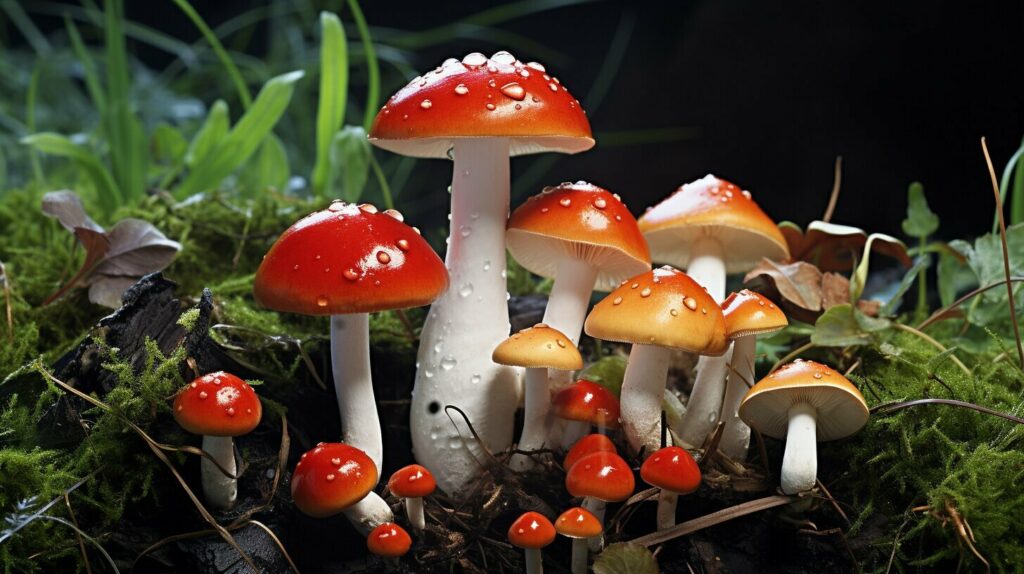
| Type of Mushroom | Potential Toxicity |
|---|---|
| Death Cap | Deadly, can cause liver failure |
| Destroying Angel | Highly toxic, can lead to organ failure |
| Fly Agaric | Poisonous, can cause hallucinations and gastrointestinal upset |
| Galerina marginata | Highly toxic, can cause liver and kidney damage |
Remember, it’s not worth risking your health or the well-being of your loved ones. Take the necessary precautions, educate yourself about yard mushrooms, and always exercise caution. By doing so, you can appreciate the beauty of these fungi while staying safe.
Cultivating Yard Mushrooms: A Guide for Enthusiasts
If you have an interest in growing your own yard mushrooms, there are several common species that are relatively easy to cultivate and can provide a rewarding experience. These species include the oyster mushroom, shiitake mushroom, and wine cap mushroom. Each variety has its own unique characteristics and requirements, but with a little care and attention, you can enjoy a bountiful harvest right in your own backyard.
To start, you’ll need to gather the necessary materials. Mushroom spawn, which is the mycelium-covered growth material, can be purchased from specialty mushroom suppliers or obtained by collecting mushroom spores. You’ll also need a substrate, such as straw, wood chips, or sawdust, which will provide the nutrients for the mushrooms to grow.
Once you have your materials, you can begin the cultivation process. First, prepare your substrate by sterilizing it to eliminate any competing organisms. Next, mix the mushroom spawn into the substrate and transfer the mixture to a suitable container or growing bed. Keep the environment moist and at the appropriate temperature for the specific mushroom species you’re cultivating.
| Mushroom Variety | Preferred Growing Conditions |
|---|---|
| Oyster Mushroom | Temperature: 65-75°F (18-24°C) Humidity: 85-95% Substrate: Straw, cardboard, or coffee grounds |
| Shiitake Mushroom | Temperature: 55-75°F (13-24°C) Humidity: 80-90% Substrate: Hardwood logs or sawdust |
| Wine Cap Mushroom | Temperature: 60-70°F (15-21°C) Humidity: 70-80% Substrate: Wood chips or straw |
Remember to monitor the moisture levels of the growing medium and provide adequate ventilation to prevent mold or other issues. With proper care, you should start to see mushroom growth within a few weeks. Harvest the mushrooms when they reach their desired size, typically before the caps fully open. Enjoy your homegrown mushrooms in a variety of culinary dishes, or share the experience with friends and family.
By cultivating yard mushrooms, you not only have the opportunity to enjoy delicious, fresh mushrooms but also gain a deeper appreciation for the intricacies of nature. The process of growing your own food can be incredibly rewarding and can help you connect with the natural world right in your own backyard.
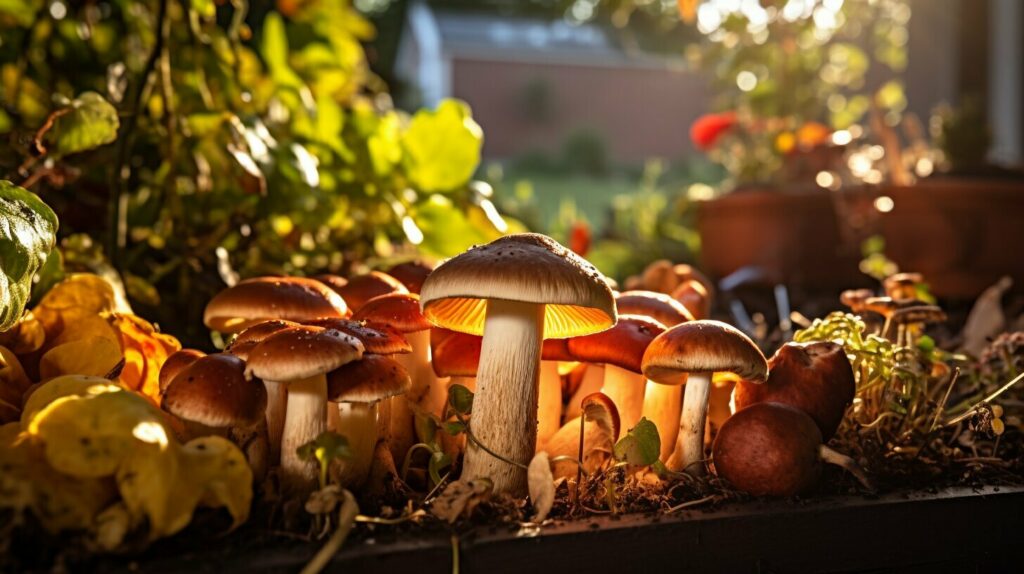
Understanding the various types of yard mushrooms, their identification, and potential risks is essential for anyone interested in exploring the fascinating world of these fungi wonders in their own backyard.
Mushrooms that grow in backyard lawns are a common sight and can be intriguing, but it’s important to remember that some mushrooms can be poisonous. Backyard mushrooms are the fruiting bodies of underground fungi that play a vital role in breaking down organic matter in the soil. They thrive in environments rich in organic material, damp and humid conditions, and shady or sheltered areas.
Common types of backyard mushrooms include the ringless honey mushroom, field or meadow mushroom, common stinkhorn, mower’s mushrooms, shaggy ink cap, fly agaric, fairy ring mushroom, and giant puffball. It’s important to properly identify mushrooms and exercise caution when foraging or consuming them. While mushrooms can add beauty to a lawn and contribute to the ecosystem, their presence can also indicate underlying issues such as poor drainage or excessive thatch buildup.
It’s essential to teach children and keep pets away from mushrooms, as some can be toxic or deadly if ingested. As with any outdoor activity, it’s crucial to be aware of potential risks and take necessary precautions. By understanding the different types of yard mushrooms, their identification, and the potential risks associated with them, enthusiasts can safely enjoy and appreciate the wonders of these fungi in their own backyard.
FAQ
Are all yard mushrooms poisonous?
No, not all yard mushrooms are poisonous. However, it is important to properly identify mushrooms before consuming them, as some can be toxic or deadly if ingested.
How can I identify common yard mushrooms?
Common yard mushrooms can be identified by their distinct characteristics such as shape, color, and size. It is recommended to use a field guide or consult with an expert to ensure accurate identification.
Can mushrooms in my yard indicate underlying issues?
Yes, the presence of mushrooms in your yard can indicate underlying issues such as poor drainage or excessive thatch buildup. It is important to address these issues to maintain a healthy lawn.
Are there any edible yard mushrooms?
Yes, there are edible yard mushrooms such as the meadow mushroom and giant puffball. However, it is crucial to be absolutely certain of their identification before consuming them.
What purpose do yard mushrooms serve in the ecosystem?
Yard mushrooms play a vital role in breaking down organic matter in the soil, enriching it with nutrients. They contribute to the ecosystem by promoting healthy soil and supporting other organisms.
How can I prevent and manage yard mushrooms?
Proper lawn care practices, such as improving drainage and reducing thatch buildup, can help prevent excessive mushroom growth. If mushrooms do appear, they can be safely removed by cutting or raking them.
What are the potential risks associated with yard mushrooms?
Some yard mushrooms can be toxic if ingested, causing symptoms ranging from mild stomach upset to more severe poisoning. It is important to keep children and pets away from yard mushrooms to avoid any potential risks.
Can I cultivate my own yard mushrooms?
Yes, it is possible to cultivate certain yard mushrooms at home. Varieties such as the meadow mushroom and shaggy ink cap are suitable for cultivation and can be a rewarding hobby for enthusiasts.

